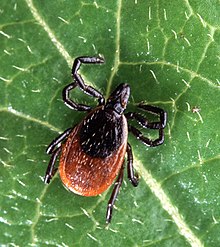
Will we soon have vaccines to protect us from Lyme disease? It turns out that there are two possible vaccines being tested right now, including one based on mRNA technologies (same as the Covid vaccines).
The mRNA vaccine has has been successfully tested in mice so far, and yes - it protected the mice from being infected with the bacterium Borrelia burgdorferi which causes Lyme disease. The second one is an intranasal protein vaccine (an established vaccine type) and is currently being tested on humans. But both vaccines are a while off yet.
Meanwhile, we're all waiting, waiting, waiting for a Lyme disease vaccine.
Excerpts from The Scientist - Newly Developed mRNA Vaccine Protects Against Lyme Disease
After walking through a forest or field of tall grass, public health agencies in many countries advise people to check their clothes, pets, and bodies for unwanted hitchhikers—ticks. These arthropods feed on the blood of mammals, such as mice, deer, livestock, and humans, as well as lizards and birds.1 Additionally, Ixodes ticks act as vectors, where they transfer disease-causing bacteria, viruses, or protozoa to their host during feeding.
Scientists are particularly concerned about ticks transmitting bacteria from the Borrelia burgdorferi sensu lato complex–a group of spirochetes that includes the originally discovered species, B. burgdorferi. Researchers have determined that some of this complex’s genospecies cause Lyme disease in humans. During the disease’s early stages, patients often experience a bullseye-patterned skin rash emanating from the bite site, as well as fever, headache, and fatigue.3
Although clinicians treat diagnosed patients with antibiotics, undetected Lyme disease leads to more severe symptoms including meningitis, carditis, arthritis, and facial paralysis.3 Consequently, researchers are seeking approaches that prevent new infections. In a recently published Molecular Therapy paper, scientists produced an mRNA-based vaccine against Lyme disease.4
“It is the most common vector-borne disease in the United States,” said Matthew Pine, the lead author of this study and a former doctoral student in the laboratories of Norbert Pardi and Drew Weissman at the University of Pennsylvania. Because of climate change and habitat fragmentation, Lyme disease prevalence and distribution are rapidly increasing in North America and Europe.5 “When I started graduate school, the figure that I used was there are about 300,000 cases every year [in the United States]. But four years into my research, the standard number had changed to almost 500,000.”
.... Currently, a new recombinant OspA protein vaccine is going through phase III clinical trials, but as of right now, there are no prophylactic vaccines approved by the FDA to prevent Lyme disease in humans.
“I think that for Lyme disease vaccines, the more options, the better,” said Maria Gomes-Solecki, a microbiologist and immunologist from the University of Tennessee Health Science Center, who was not involved in the study. Her team recently developed an intranasal, viral vector-delivered vaccine based on OspA and summarized their results in a preprint posted on Research Square.
